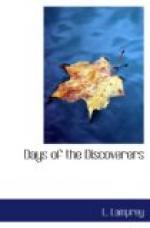The Spanish strangers were housed in a great stone palace and entertained no less magnificently than the gifts of the Emperor had led them to expect. The houses were ceiled with cedar and tapestried with fine cotton or feather work. Moteczuma’s table service was of gold and silver and fine earthenware. The people wore cotton garments, often dyed vivid scarlet with cochineal, the men wearing loose cloaks and fringed sashes, the women, long robes. Fur capes and feather-work mantles and tunics were worn in cold weather; sandals and white cotton hoods protected feet and head. The women sometime used a deep violet hair-dye. Ear-rings, nose-rings, finger-rings, bracelets, anklets and necklaces were of gold and silver.
Moteczuma himself, a tall slender man about forty years old, came to meet them in a palanquin shining with gold and canopied with feather-work. As he descended from it his attendants laid cotton mats upon the ground that he might not soil his feet. He wore the broad girdle and square cloak of cotton cloth which other men wore, but of the finest weave. His sandals had soles of pure gold. Both cloak and sandals were embroidered with pearls, emeralds, and a kind of stone much prized by the Aztecs, the chalchivitl, green and white. On his head he wore a plumed head-dress of green, the royal color. When Cortes with his staff approached the building set apart for their quarters, Moteczuma awaited them in the courtyard. From a vase of flowers held by an attendant he took a massive gold collar, in which the shell of a certain crawfish was set in gold and connected by golden links. Eight golden ornaments a span long, wrought to represent the same shell-fish, hung from this chain. Moteczuma hung the necklace about the neck of Cortes with a graceful little speech of welcome.
[Illustration: “Moteczuma awaited them in the courtyard”—Page 162]
The Aztec Emperor was making the best of a situation which he did not like at all. In other Mexican cities Cortes had ordered the idols cast headlong down the steps of the teocalli, the temples cleansed, and a crucifix wreathed in flowers to be set up in place of the red altar stained with human blood. He was attended by some seven thousand native allies from tribes considered by the Aztecs as wild barbarians. His daring behavior and military successes had all been reported to Moteczuma by the picture-writing of his scribes. There was a tradition among the Aztecs that some day white bearded strangers would come, destroy the worship of the old gods of blood and terror, and restore the worship of the fair god Quetzalcoatl. Before the white men landed there had been earthquakes, meteors and other omens. Would the old gods destroy the invaders and all who joined them, or was this the great change which the prophets foretold? Who could say?




